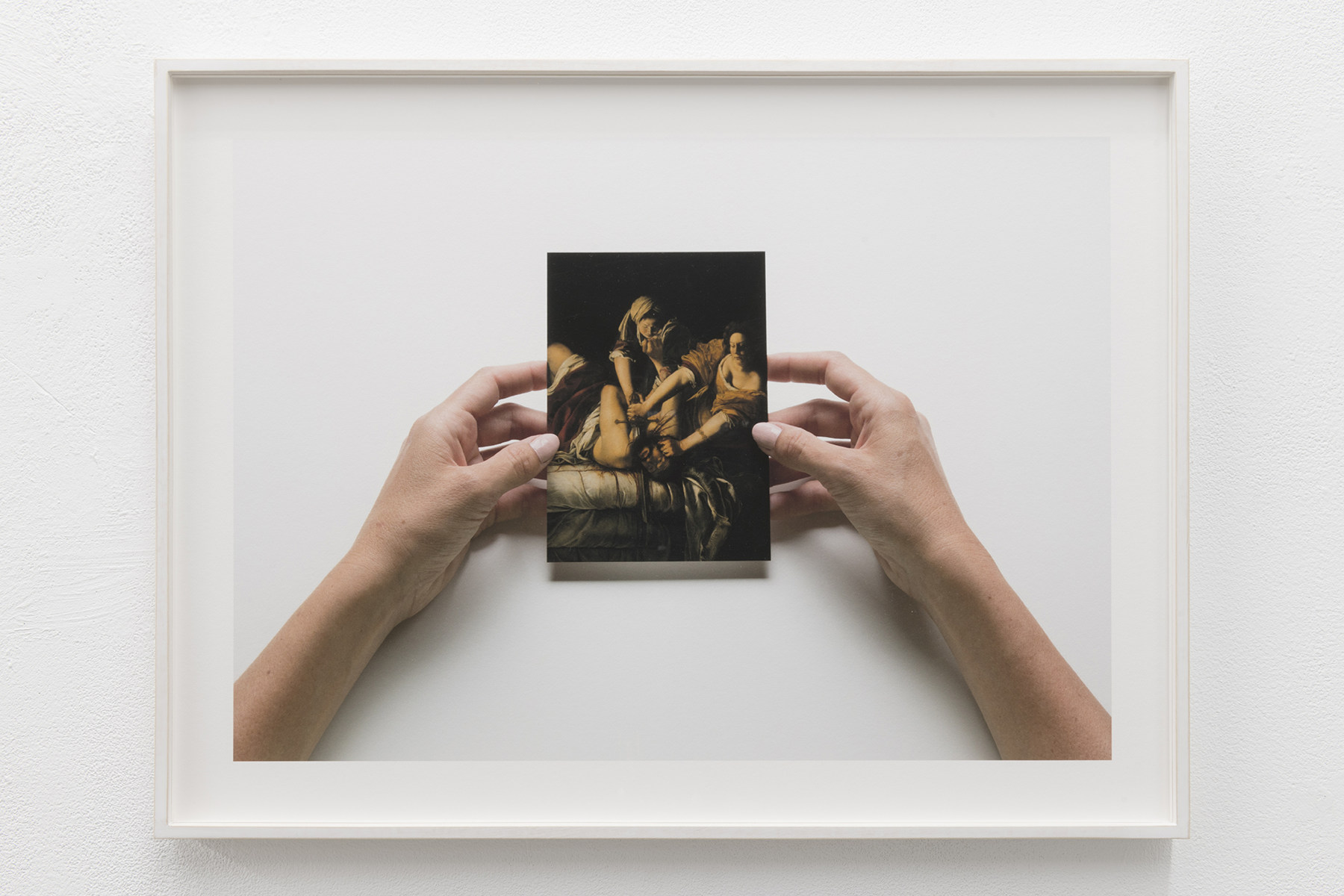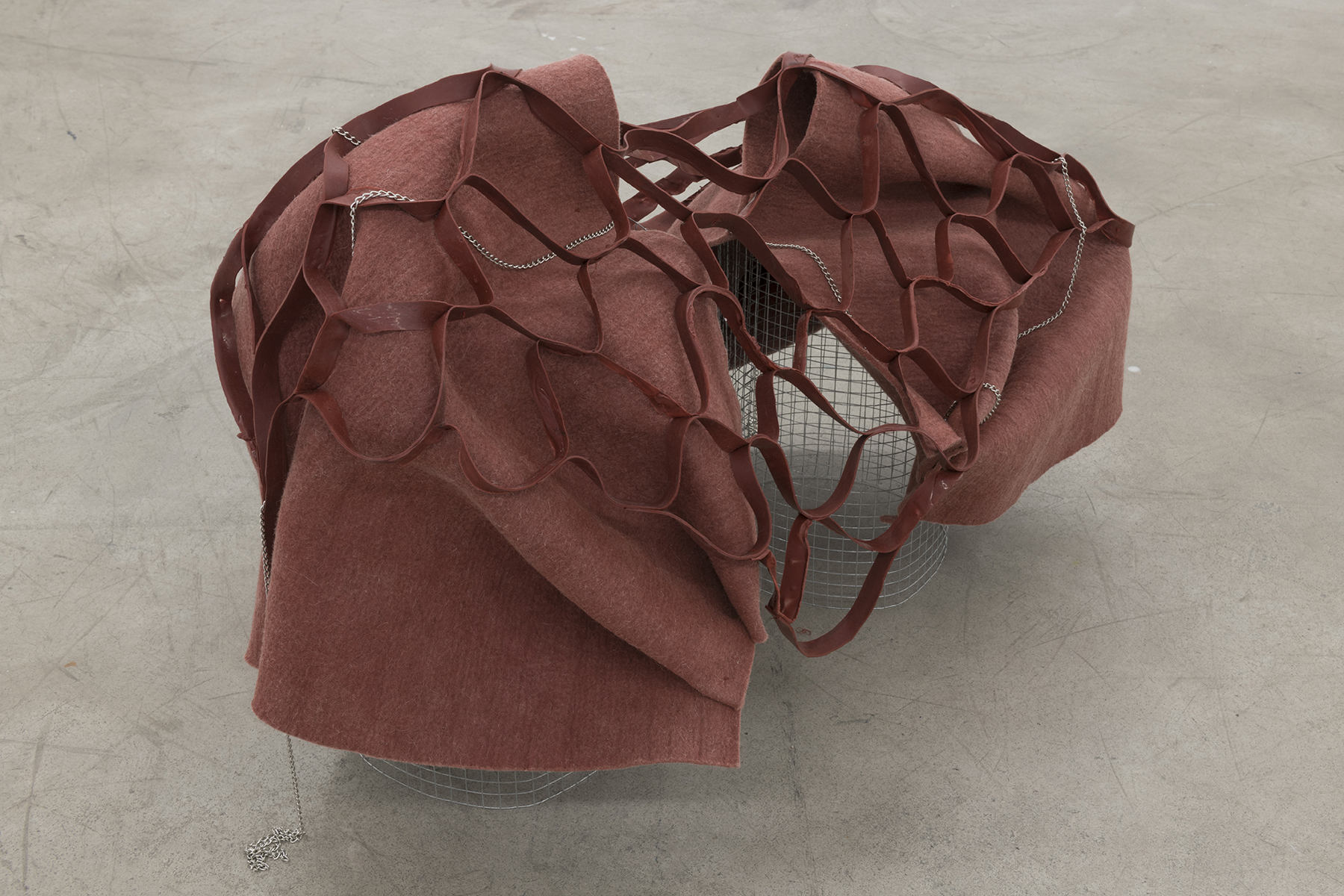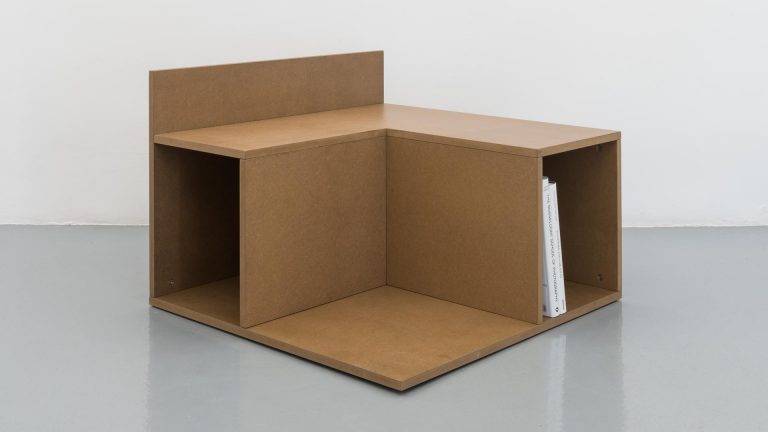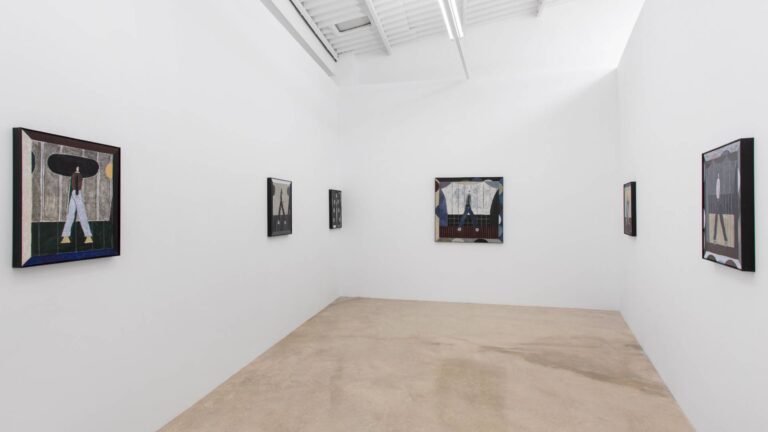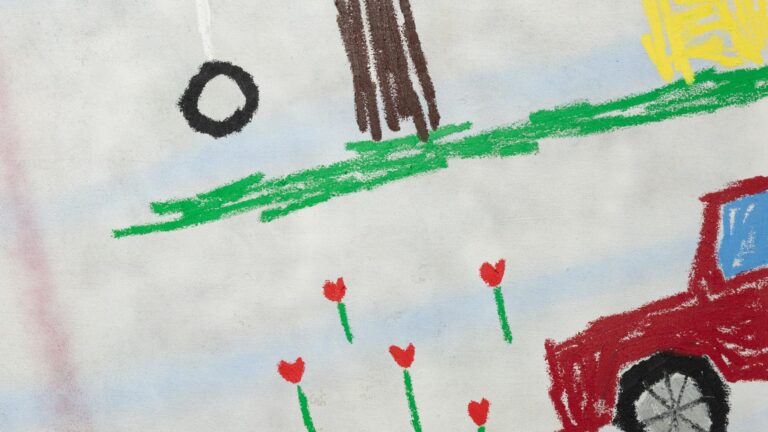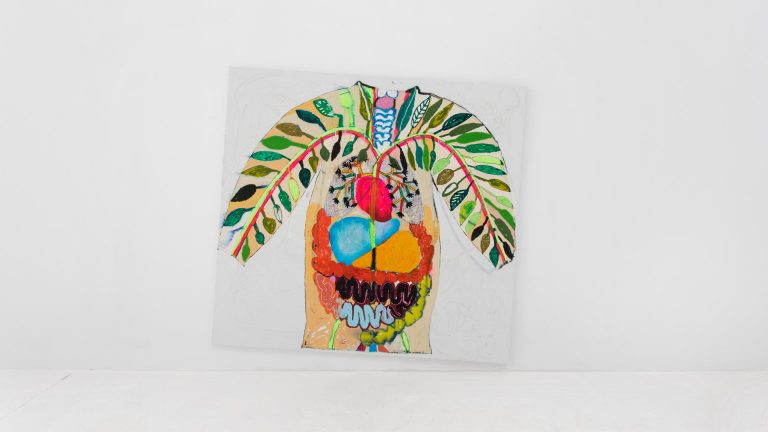Artist: Mercedes Azpilicueta
Exhibition title: The Old Dream of Symmetry
Venue: Nogueras Blanchard, Madrid, Spain
Date: February 14 – March 23, 2019
Photography: Roberto Ruiz, all images copyright and courtesy of the artist and Nogueras Blanchard, Madrid
They say that History does not repeat itself, but it often rhymes. The gestures we perform bear the echoes of histories, narratives and other expressions that precede us; we have to learn to read through their inner lignings to find traces of the past. That is what artist Lea Lublin proposed when she analyzed the Baroque painting Judith Slaying Holofernes (1614-1620) by Artemisia Gentileschi: there are “unspeakable” remains that are the result of transgressions, which are imprisoned in the codes of pictorial representation. Artemisia had been raped by her tutor some years prior to the painting of this scene, whose explicit violence has been recurrently interpreted as a sign of psychological vengeance, in which the painter would see herself represented in the figure of Judith. According to Lublin, the painting is the art of duplicity and deceitfulness, enigma and verisimilitude.
Lublin was part of the group of feminists that saved Artemisia’s story from oblivion during the last century, and it is through her work that Mercedes Azpilicueta came accross it. Her research process into the Italian painter’s work is documented in the series of framed prints (Artemisia Gentileschi e il suo tempo, Firenze; Artemisia Gentileschi e il suo tempo, Napoli; The Artemisia Files: Artemisia Gentileschi for Feminists and Other Thinking People; Artemisia Gentileschi. Giuditta che decapita Oloferne, 1620 -1621 circa, Firenze Galleria degli Uffizi; all 2018) in which the artist holds several books and a postcard depicting the two existing versions of Holofernes’ beheading by Artemisia-Judith and her servant. Another approach to the work is made evident in the audio piece (Cuerpos Pájaros, narrativa 1; 2018) that momentarily invades the space, describing a manifold approach – physical, institutional, personal and choreographic – to the version of the painting exhibited at the Galleria degli Uffizi in Florence. The last component (Artemisia Gentileschi: Judith Slaying Holofernes, 2019) is textile: the outlines of the scene have been embroidered onto two linen fabrics with wine colored threads that spring up profusely. Covered by a layer of silk, both pieces create a diptych in which the image is confronted by its mirrored reflection; both doubled and duplicitous, as Lublin implied.
The women’s cruelty depicted in the original painting, the dynamism of their bodies writhed with determination, as well as the different optical and meaning-producing strategies put at play, are here a sort of Baroque drive that animates Azpilicueta’s project. Two figures hang in the center of the room, Hommage to the back of Natività di San Giovanni Battista, Pontormo, 1526 (I) and (II). They are a revision of two winged creatures that appear in the background of the Mannerist painting Natività de San Giovanni Battista by Pontormo: two fantastic, monstrous beings with an old man’s head and a rib-striated torso. In Azpilicueta’s version these become bird-bodies, made out of folds and creases of soft felt, covered by meshes and garlands of oily latex, and punctuated by metal chains. All the cloths in the exhibition have been died in a colour palette reminiscent of blood, mud and earth tones, evoking a Baroque viscerality that is no longer just European, but also Colonial, and even Postmodern —especially in its poetical Neobaroque version of Rio de la Plata’s underworlds.
Azpilicueta began working with cloths and textiles during her university period in Buenos Aires, and then moved to Rotterdam, where she was introduced to performance art. It was in Italy, where she has been living recently for two years before heading back to The Netherlands, where she connected again with craft work, as well as with her fascination with the Baroque. A movement that she understands as a transhistorical force, or an expressive drive that inflames language, meaning and aesthetic forms in its way. Precisely, a small plaque in the room praises against “El viejo sueño de la simetría” (The Old Dream of Symmetry, 2019). It is made from the recycled silver necklaces from the artist’s youth, melted by a friend in her natal village, where there’s a traditional silversmithing tradition. The inscription is a quote by feminist linguist, philosopher and psychoanalyst Luce Irigaray, that references the useless Freudian search for correspondence amongst feminine and masculine sexuality; again, another specular illusion to dismantle. It is in this context that a voice scorns the pretenses of classical representation. But, also, a warning coming from afar to summon us to read against the grain of mirages of meaning and rhymes of the past contained in every artwork.
-Julia Morandeira Arrizabalaga
Mercedes Azpilicueta was born in La Plata, Argentina, in 1981. Lives and works in Rotterdam, The Netherlands.
She received the Pernod Ricard Fellowship, Paris in 2017 and was artist-in-residence at the Rijksakademie van beeldende kunsten in Amsterdam in 2015-16. She has an MFA from the Dutch Art Institute/ArtEZ, Arnhem (2013), and a BFA from the National University of the Arts, Buenos Aires (2007); where she also participated in the Artists´ Program 2009-10 at Torcuato Di Tella University.
Exhibitions and performance works include, among others, Buenos Aires Museum of Modern Art, Buenos Aires, Argentina (2018); REDCAT Gallery, Los Angeles, USA (2018); Villa Vassilieff, Paris, France (2018); MACBA, Barcelona, Spain (2018), Museion, Bozen, Italy (2018), D21 Kunstraum, Leipzig, Germany (2018); Centro de Arte 2 de Mayo, Móstoles, Spain (2017); Chinese European Art Center, Xiamen, China (2017); Onomatopee, Eindhoven, The Netherlands (2016); TENT, Rotterdam, The Netherlands (2015); Móvil, Buenos Aires, Argentina (2015); Irish Museum of Modern Art, Dublin, Ireland (2014); Het Veem Theatre, Amsterdam, The Netherlands (2014).
Azpilicueta’s future solo projects include Bestiario de Lengüitas, CentroCentro, Palacio de Cibeles, Madrid; and Positions #5, Van Abbemuseum, Eindhoven, The Netherlands.
Mercedes Azpilicueta, The Old Dream of Symmetry, 2019, exhibition view, Nogueras Blanchard, Madrid
Mercedes Azpilicueta, The Old Dream of Symmetry, 2019, exhibition view, Nogueras Blanchard, Madrid
Mercedes Azpilicueta, Hommage al reverso de Natività di San Giovanni Battista, Pontormo, 1526 (I), 2019, Wool felt, red oxide and caput mortuum natural dyes, hand-made dyed eco-latex, metal chains, Dimensions variable
Mercedes Azpilicueta, Hommage al reverso de Natività di San Giovanni Battista, Pontormo, 1526 (I), 2019, Wool felt, red oxide and caput mortuum natural dyes, hand-made dyed eco-latex, metal chains, Dimensions variable
Mercedes Azpilicueta, The Old Dream of Symmetry, 2019, exhibition view, Nogueras Blanchard, Madrid
Mercedes Azpilicueta, Artemisia Gentileschi e il suo tempo, Firenze, 2018, Giclée print on cotton paper, 36,5 × 49 × 3 cm
Mercedes Azpilicueta, The Old Dream of Symmetry, 2019, exhibition view, Nogueras Blanchard, Madrid
Mercedes Azpilicueta, The Old Dream of Symmetry, 2019, exhibition view, Nogueras Blanchard, Madrid
Mercedes Azpilicueta, The Artemisia Files: Artemisia Gentileschi for Feminists and Other Thinking People, 2018, Giclée print on cotton paper, 36,5 × 49 × 3 cm
Mercedes Azpilicueta, The Old Dream of Symmetry, 2019, exhibition view, Nogueras Blanchard, Madrid
Mercedes Azpilicueta, Artemisia Gentileschi: Judith decapitando a Holofornes (I), 2019, Natural linen, natural two-colored silk, thread, 200 × 140 cm
Mercedes Azpilicueta, Artemisia Gentileschi: Judith decapitando a Holofornes (II), 2019, Natural linen, natural two-colored silk, thread, 200 × 140 cm
Mercedes Azpilicueta, Artemisia Gentileschi: Judith decapitando a Holofornes (I), 2019, Natural linen, natural two-colored silk, thread, 200 × 140 cm
Mercedes Azpilicueta, The Old Dream of Symmetry, 2019, exhibition view, Nogueras Blanchard, Madrid
Mercedes Azpilicueta, Artemisia Gentileschi. Giuditta che decapita Oloferne, 1620 -1621 circa, Firenze Gallerie degli Uffizi, 2018, Giclée print on cotton paper, 36,5 × 49 × 3 cm
Mercedes Azpilicueta, Hommage al reverso de Natività di San Giovanni Battista, Pontormo, 1526 (II), 2019, Wool felt, red oxide and caput mortuum natural dyes, hand-made dyed eco-latex, metal chains, 60 × 50 × 90 cm
Mercedes Azpilicueta, The Old Dream of Symmetry, 2019, exhibition view, Nogueras Blanchard, Madrid
Mercedes Azpilicueta, The Old Dream of Symmetry, 2019, exhibition view, Nogueras Blanchard, Madrid
Mercedes Azpilicueta, Artemisia Gentileschi e il suo tempo, Napoli, 2018, Giclée print on cotton paper, 36,5 × 49 × 3 cm
Mercedes Azpilicueta, El viejo sueño de la simetría, 2019, Recycled Argentine silver, 5,5 × 9,5 cm















